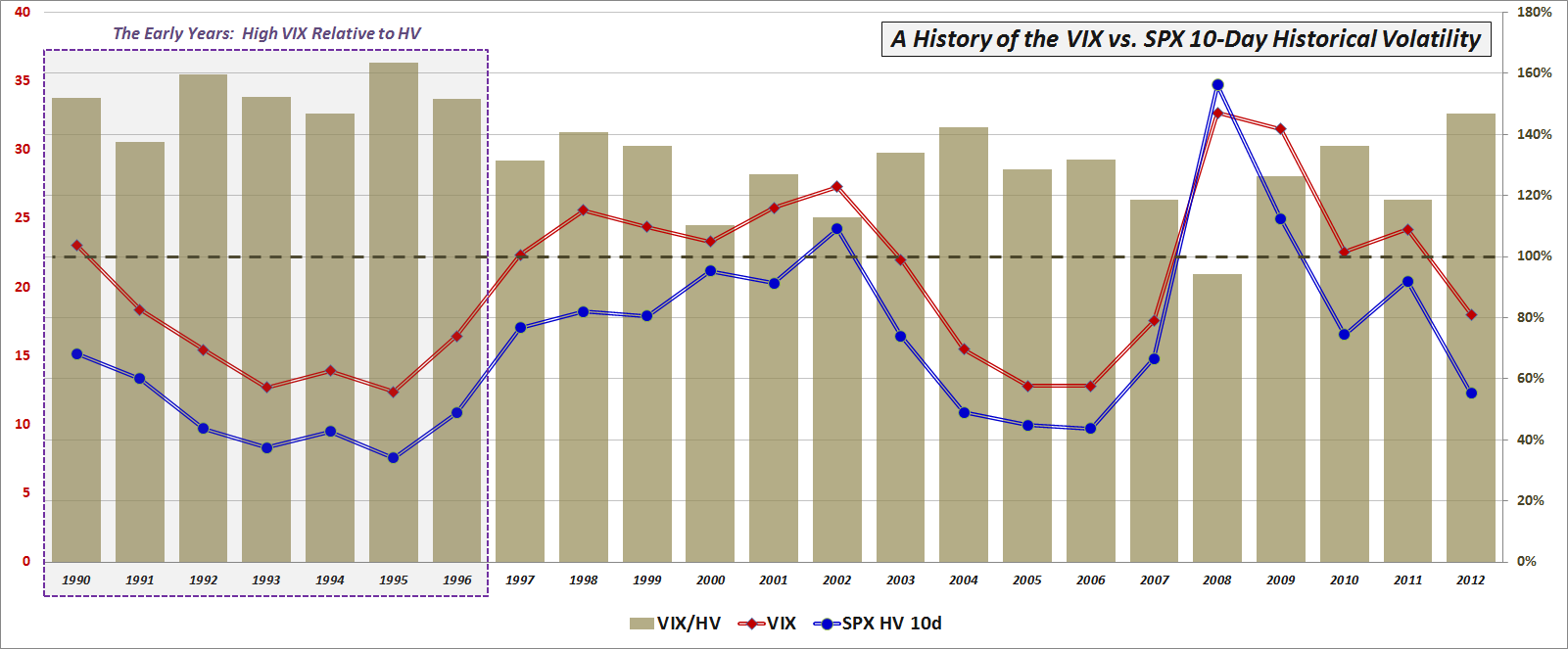Ratio of VIX to Realized Volatility Higher Than Any Year Since 1996
Before I dive into a series of posts about the VIX futures, I think it is important to add some context in the form of several observations about the relationship between the VIX and the historical volatility (HV) of the S&P 500 index. In the absence of any information about the future, it turns out that historical volatility (a.k.a. realized volatility or statistical volatility) can provide a reasonably accurate measure of future volatility. In fact, it is more difficult than one might imagine to incorporate information about the future to come up with a better estimate of future volatility than what can be gleaned just by extrapolating from recent realized volatility.
Looking at historical data, the VIX has an established history of overestimating future realized volatility. In fact, in the 23 years of VIX historical data, there was only one year – 2008 – in which realized volatility turned out to be higher than that which was predicted by the VIX.
As the chart below shows, early traders made a habit of dramatically overestimating future volatility. From 1990-1996, for instance, the VIX overshot realized volatility by an average of 49%. Since 1997, the magnitude of that overshoot has dropped dramatically, to about 24%, as investors apparently began to realize that they had been overpaying for portfolio protection in particular and for options in general.

[source(s): CBOE, Yahoo]
That being said, 2012 has been an unusual instance in which the VIX has overestimated 10-day historical volatility in the SPX by 47% – the biggest cushion since 1996. Not surprisingly, low realized volatility tends to depress the VIX and the front end of the VIX futures term structure in general. For that reason, the unusually low average 10-day historical volatility of 12.25 experienced so far in 2012 can serve as a partial explanation for the steepness of the VIX futures term structure (extreme contango) yet given the history of even lower volatility numbers during 2004-2007, the low historical volatility for 2012 is at best a very small portion of the full explanation. Two better potential explanations for the steep VIX futures term structure are the psychology of the 2008 financial crisis and its aftermath (i.e., disaster imprinting, availability bias, the recency effect, etc.) and expectations of future higher volatility due to a geopolitical and macroeconomic overhang that has generated a much higher level of anxiety about future prospects than in more uneventful economic times. Then, of course, there is the issue of the role of mushrooming growth in VIX exchange-traded products as an influence on the VIX futures term structure.
Before I address those issues in more detail, however, the next installment in this series is a discussion of the evolution of the VIX futures term structure.
Related posts:
- VIX Premium to Historical Volatility at Record High in Q1
- S&P 500 Index 20-Day Historical Volatility Hits 39-Year Low
- VIX and Historical Volatility Settling Back into Normal Range
- Chart of the Week: No More Free Lunch for Volatility Sellers?
- The Gap Between the VIX and Realized Volatility
- What Is Historical Volatility?
- Rule of 16 and VIX of 40
- Availability Bias and Disaster Imprinting
- VIX Data to Support Availability Bias and Disaster Imprinting Hypothesis
- Calculating Centered and Non-Centered Historical Volatility
- Thinking About Volatility (First in a Series)
Disclosure(s): none

